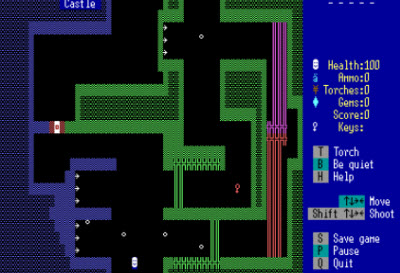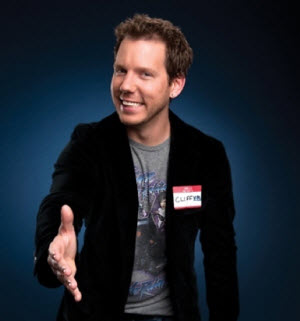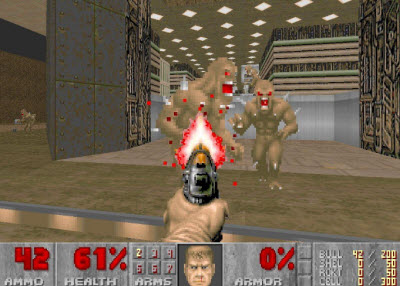 GB: Your first game was ZZT. What was that?
GB: Your first game was ZZT. What was that?
TS: Yes, ZZT is the first game I shipped. That was a really short project. It only took me about six months to create. I was just fooling around on my computer. My father bought me an IBM clone at the time, a 286. It was a simple game, not a big project. It was a really fun little text-based game. It didn’t have any graphics. It had text characters like smiley faces. It had big letters for enemy characters. You would explore levels and collect treasures and fight monsters. I showed it to neighborhood kids and friends from high school. They all loved it. It was pretty but it was fun I released that in 1991 and it was unique in one way. It included an editor so you could create game levels. It fostered a community of people who created levels and shared them on bulletin boards. That was a precursor to the internet. We talked about the indie community all using the Unreal development kit, but back then it was building game modes in ZZT.
GB: Were you inspired to enable user-generated content?
TS: ZZT started all that. It was a practical matter. I made the editor first and started making game levels with it. I kept the editor really polished. It was a whimsical decision to release the editor to the world. I thought a couple of people would do it. But tens of thousands of people in the game industry created their own levels with ZZT when they were kids.
 GB: How did you decide to go into game development for a living?
GB: How did you decide to go into game development for a living?
TS: ZZT was just a fun project. But when I saw how much fun people had when I shared the game to them, I decided to release it commercially. Around that time, in 1991, Apogee Software was a shareware game company. Scott Miller had this cool business model. He would create a trilogy and release the first part for free. Then they would sell you the sequels through mail order. It gave them a taste for the game and a reason to spend money. I released ZZT that way and it was immediately started getting several orders a day. That was $100 a day of income for a kid in high school and that was really neat at the time. I realized at that point that I could actually build a real business around it if I gave it an even greater effort. And so from that point on, I really appreciated Epic as a business. I started to create much more serious and bigger game, which was Jill of the Jungle. That was Nintendo style platform game where you were jumping around on these two-dimensional scrolling levels. I had a musician and an animator to help me with the areas where I was weak. I did all the programming and released that game. It was selling about 30 copies a day and it was enough to start hiring people to help with sales and mail floppy disks. I used that game as a vehicle to advertise to other game developers to join Epic Games.
 GB: And that is how you ran into people like Cliff “CliffyB” Bleszinski and Mark Rein.
GB: And that is how you ran into people like Cliff “CliffyB” Bleszinski and Mark Rein.
TS: Yeah,, with Jill of the Jungle, we reached out and met Cliff Bleszinski, James Scmatz and all the other really Epic authors who played the game and saw the ad. Mark Rein called me up and described how much money he could make by doing marketing and sales for Epic. Mark was in Toronto and I was in Maryland. Mark flew out to visit and we talked about business possibilities. So he came to my house and I just received the big batch of disks in from the the authors and one of them was Cliff Bleszinski’s game, Dare to Dream. So Mark picked up his cell phone and call Cliff and told him how awesome Epic would be. That’s how Epic and Cliff Bleszinski ended up together. We started to put different people together with complementary talent. We met this really brilliant Dutch programmer, Arjan Brussee, who had done some incredible graphics demos. We hooked him up with Cliff Bleszinski to design Jazz Jackrabbit. Cliff did the art work and design. Arjan did all the coding. He had a wicked-fast engine running games at 60 frames a second on old PCs. So that’s how we expanded. We brought out all the old-time Epic authors to do games like Jazz Jackrabbit, Epic Pinball, One Must Fall — a lot of games that old-time gamers still recognize today.
GB: You guys have stuck together for a long time. What do you think is the secret to keeping the team together?
TS: Nobody at Epic has a huge ego. I think that’s a huge part of it. We all have respect for each other and recognize that we are really complementary. Cliff and Arjan together were able to create a much better game together than either one could have done on their own. It has fostered a collaborative environment where no one person thinks they are the master of all of game development. We’ve also tried to create a fun place to work with a bunch of assets, a friendly working environment, and financial stability.
GB: Nothing holds a team better than success?
TS: Sometimes success is a harbinger of doom. If you have a bunch of egotistical people together in a room, just struggling, it tends to hold together better than a bunch of egotistical people who are really successful. They all have unique talents. A lot of our success is due to the people involved. Cliff has been here a long time and is incredibly creative. He has always been designing his own games, but he has also been playing all of the other games that Epic has published. He can make a big long list of what can make the game better. It’s cool to see people grow.
GB: Do you share some of the same passion for gaming or is more of your interest in the technology and graphics? Could you be making a Mickey Mouse game and still be happy as long as it had outstanding graphics?
TS: I could be happy making any game. It’s always been the programming for me. Solving big technical challenges has excited me. I’ve always played game just enough to know what they are doing and how they work. I played Sonic the Hedgehog for a few hours. I’ve only finished two games in my life. Doom and Portal. The game design and quality of the game experience has been the work of Cliff and others. The only time I was a competitive game designer was when we had 16-color graphics.
 GB: So finishing Doom was enough to figure out what you wanted to do with Unreal?
GB: So finishing Doom was enough to figure out what you wanted to do with Unreal?
TS: I was addicted to Doom. Once in a while, a game comes out that is so far above other games that it is hard to imagine what they are ally doing. Most of the games have been products of engines. Moving from Wolfenstein to Doom and Quake was so incredibly impressive for id. They created a whole new level of immersiveness.
GB: Some companies like Nintendo have stayed with cartoon graphics. Shigeru Miyamoto has done his games, but you guys have pushed the edge on 3D. What do you think of that difference?
TS: It’s really a matter of artistic style. Even when you do cartoon graphics, you can still apply some really serious technology to it. If you look at a Pixar movie, they have impressive effects. It’s more a question of style than technological prowess. You can build a cartoon version of Gears of War, but still preserve all of the key elements of the game play. Not that Epic would ever do that.
GB: What is your best memory of the making of Gears of War?
TS: That project went through so many phases of design. It started out as Unreal Warfare, an extension of the Unreal universe. It broke off into a series of design and artistic thrust that made it completely separate. We had a cover system. The point where I was impressed was when we got multiplayer working from a third-person perspective. At that point, with the third person camera, the multiplayer and the visual style, it was clear we were delivering an entirely new type of game experience. It was a cover game with a much more realistic kind of combat. A multiplayer game before that was where you were running at 35 miles per hour. You would jump 12 feet in the air.
 GB: What do you really want to see in a video game still?
GB: What do you really want to see in a video game still?
TS: Ah, gee. The whole time I have been playing games, the times when I have been most impressed are when I played Doom. Seeing 3D graphics. There were multiplayer text-based dungeon games around 1980 or so. You would log into the game and just see a huge number of other people. That was a detailed, immersive experience. Massively multiplayer online games have tried to capture that but I’ve never had the same feeling in an MMO. They have always felt rote and repetitive. I would like to have that feeling again where it was a completely free-wheeling and open adventure. That stands out for me.
GB: Are you getting a nice speech together for your award?
TS: I only have 2.5 minutes. The last winner created a poem.
GB: Do you agree with Bing Gordon, that we are in the Golden Age of gaming?
TS: There were many golden ages. Like the 2D games and 3D games. It’s hard to tell what the future holds. To me it is really cool to be a part of everybody’s lives, to be pervasive. People sit around the TV. They play on the iPhone. They play FarmVille. It’s just cool to see gaming everywhere. It’s not just an experience for hardcore geeky guys. That’s cool.
VentureBeat's mission is to be a digital town square for technical decision-makers to gain knowledge about transformative enterprise technology and transact. Learn More
